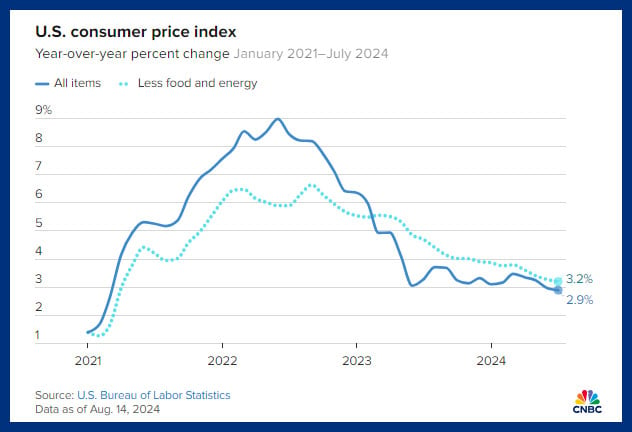The U.S. is set to cut rates—finally
After much speculation about when the U.S. will finally begin cutting its interest rates, the CME FedWatch tool reports a 100% chance that the U.S. Federal Reserve will cut its rates in September. Market watchers are pretty confident, with a 36% chance that the U.S. Fed will go right to a 0.50% cut instead of nudging the rate down. And looking ahead, the futures market predicts a 100% chance of 0.75% in rate cuts by December this year, with a 32% chance of a 1.25% rate decrease. The forecasts became stronger this week as the annualized inflation rate in the U.S. slowed to 2.9%, its lowest rate since March 2021. There are a lot of percentages here, but the gist is people are expecting big interest rate cuts.
Those probabilities should take some of the currency pressure off of the Bank of Canada (BoC) when it makes its next interest rate decision on September 4. If the BoC were to continue to cut rates at a faster pace than the U.S. Fed, the Canadian dollar would substantially depreciate and import-led inflation would likely become an issue.

Here are some top-line takeaways from the U.S. Labor Department July CPI report:
- Core CPI (excluding food and energy) rose at an annualized inflation rate of 3.2%.
- Shelter costs rose 0.4% in one month and were responsible for 90% of the headline inflation increase.
- Food prices were up 0.2% from June to July.
- Energy prices were flat from June to July.
- Medical care services and apparel actually deflated by 0.3% and -0.4% respectively.
When combined with the meagre July jobs report, it’s pretty clear the U.S. consumer-led inflation pressures are receding. As the U.S. cuts interest rates and mortgage costs come down, it’s quite likely that shelter costs (the last leg of strong inflation) could come down as well.
Walmart: “Not projecting a recession”
Despite slowing U.S. consumer spending, mega retailers Home Depot and Walmart continue to book solid profits.
U.S. retail earnings highlights
Here are the results from this week. All numbers below are reported in USD.
- Walmart (WMT/NYSE): Earnings per share of $0.67 (versus $0.65 predicted). Revenue of $169.34 billion (versus $168.63 billion predicted).
- Home Depot (HD/NYSE): Earnings per share of $4.60 (versus $4.49 predicted). Revenue of $43.18 billion (versus $43.06 billion predicted).
While Home Depot posted a strong earnings beat on Wednesday, forward guidance was lukewarm, resulting in a gain of 1.60% on the day. Walmart, on the other hand, knocked the ball out of the park and raised its forward guidance and booked a gain of 6.58% on Thursday.
Walmart Chief Financial Officer John David Rainey told CNBC, “In this environment, it’s responsible or prudent to be a little bit guarded with the outlook, but we’re not projecting a recession.” He went on to add, “We see, among our members and customers, that they remain choiceful, discerning, value-seeking, focusing on things like essentials rather than discretionary items, but importantly, we don’t see any additional fraying of consumer health.”
Same-store sales for Walmart U.S. were up 4.2% year over year, and e-commerce sales were up 22%. The mega retailer highlighted its launch of the Bettergoods grocery brand as a way to monetize the trend toward cheaper food-at-home options, and away from fast food.




